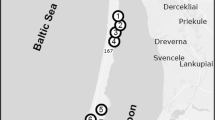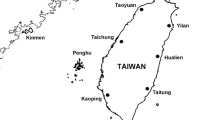Abstract
Information on circulation of rickettsiae between small mammals and their ectoparasitic mites is scarce. In this study, we investigated infestation rates of rodents with mites in some areas of SW Slovakia and the role of mites as possible vectors of pathogenic rickettsiae. A total of 615 rodents of five species were caught during 2010–2012. All individuals were examined for ectoparasites which resulted in 2821 mites belonging to three species of Laelapidae and six species of Trombiculidae. The most common Laelapidae species was Laelaps agilis (81.25 %), followed by Haemogamasus nidi, and Eulaelaps stabularis. Hirsutiella zachvatkini (16.52 %) was the dominant species of the family Trombiculidae. DNA extracted from rodent blood and ectoparasitic mites was examined for the presence of rickettsiae by PCR. By pooling mites, 345 pool samples were created, of which 112 (32.46 %) were found to be positive for the rickettsial DNA. From 487 examined rodent blood samples, rickettsial DNA was found in 46 (9.44 %). Sequencing DNA from the positive blood samples and mites revealed the identity of Rickettsia helvetica and Rickettsia monacensis. The results of the study suggest that ectoparasitic mites may be reservoirs as well as vectors of some pathogenic rickettsiae.


Similar content being viewed by others
References
Ambros M (1984) Fauna roztočov (Acari: Mesostigmata) drobných cicavcov Záhorskej nížiny a Malých Karpát. Acta Rer Natur Mus Nat Slov Bratislava 30:87–101
Ambros M (1990) Fauna roztočov (Acari: Mesostigmata) z drobných cicavcov chránenej krajinnej oblasti Ponitrie. 1. časť: Tribeč. Rosalia (Nitra) 6:229–252
Ambros M, Kalúz S (1985) Príspevok k poznaniu ektoparazitov drobných cicavcov so zreteľom na parazitické roztoče čeľ. Dermanyssoidea (Acari: Mesostigmata). In: Feriancová-Masárová Z, Halgoš J (ed) Zoonózy urbánnych a suburbánnych celkov so zvláštnym zreteľom na podmienky Bratislavy, Slovenská Zoologická Spoločnosť pri SAV, pp 198-202
Ambros M, Kalúz S (1987) Roztoče (Mesostigmata) – ektoparazity drobných cicavcov z územia Bratislavy. Acta Rer Natur Mus Nat Slov Bratislava 33:119–128
Anděra M, Horáček I (2005) Poznávame naše savce. Sobotáles, Praha
Burgdorfer W, Brinton LP (1975) Mechanisms of transovarial infection of spotted fever ricekttsiae in ticks. Ann N Y Acad Sci 266:61–72
Burgdorfer W, Varma MGR (1967) Trans-stadial and transovarial development of disease agents in arthropods. Ann Rev Entomol 12:347–376
Guo XG, Speakman JR, Dong WG, Men XY, Qian TJ, Wu D, Qin F, Song WY (2013) Ectoparasitic insects and mites on Yunnan red-backed voles (Eothenomys miletus) froma localized area in southwest China. Parasitol Res 112:3543–3549
Karg W (1971) Die freilebenden Gamasina (Gamasides), Raubmilben. In: Die Tierwelt Deutschlands und angrenzende Meeresteile, Teil 59, Fischer Verlag, Jena
Karg W (1993) Acari (Acarina), Milben Parasitiformes (Anactinochaeta) Cohors Gamasina Leach Raubmilben. In: Die Tierwelt Deutschlands, Teil 59, Gustav Fischer Verlag, Jena, Stuttgart, New York
Kocianová E (1989) Gnezdovye ektoparasity (gamazovye kleshchi) kak perenoschiky rikketsij v eksperimente. Rikketsiozy. Sbornik Nauchnykh Trudov, Leningrad 66:89–94
Kocianová E (1993) Can the gamasid mites participate in the circulation of some pathogen agens in the nature? Správy Slov Zool Spol 15:55–59
Kocianová E, Kožuch O, Bakoss P, Řeháček J, Kováčová E (1993) The prevalence of small terrestrial mammals infected with tick- borne encephalitis virus and leptospirae in the foothills of the southern Bavarian forest, Germany. Appl Parasitol 34:283–290
Kocianová E, Kožuch O (1988) A contribution to the parasite fauna in winter nests of the common mole (Talpa europea L.) and incidence of its infection with tick-borne encephalitis virus TBE and rickettsia Coxiella burnetii. Folia Parasitol 35:175–180
Kudryashova NI (1998) Kleshchi krasnotelki (Acariformes, Trombiculidae) vostochnoi Palearktiki [Chigger mites (Acariformes, Trombiculidae) of East Palearctics]. Issledovania po faune, KMK Scientific Press Ltd, Moscow
Lysý J, Nosek J, Výrosteková V, Kováčik J (1979) Isolation of Francisella tularensis from mites Haemogamasus nidi and Laelaps hilaris in western Slovakia. Zentralblatt fur Bakteriologie, Parasitenkunde, Infektionskrankheiten und Hygiene A 244(2/3):324–326
Mašán P, Fenďa P (2010) A review of the laelapid mites associated with terrestrial mammals in Slovakia, with a key to the European species (Acari: Mesostigmata: Dermanyssoidea). Institue of Zoology, Slovak Academy of Sciences, Bratislava
Michalko J, Berta J, Magir D (1986) Geobotanická mapa ČSSR. Vydavateľstvo SAV, Bratislava
Mrciak M (1958) Roztoče z radu Parasitiformes (Acari) z drobných cicavcov Vysokých Tatier. Zologické Listy 7:65–86
Mrciak M, Rosický B (1959) K fauně roztočů řádu čmelíkovců (Parasitiformes) z území ČSR. Zoologické Listy 2:143–148
Parola P, Paddock CD, Socolovschi C, Labruna MB, Mediannikov O, Kernif T, Abdad MY, Stenos J, Bitman I, Fournier PE, Raoult D (2013) Update on tick-borne rickettsioses around the world: a geographic approach. Clin Microbiol Rev 26(4):657–702
Prakash JAJ, Lal TS, Rosemol V, Verghese VP, Pulimood SA, Reller M, Dumler JS (2012) Molecular detection and analysis of spotted fever group Rickettsia in patients with fever and rash at a tertiary care centre in Tamil Nadu, India. Pathog Glob Health 106(1):40–45
Raoult D, Fournier P-E, Eremeeva M, Graves S, Kelly PJ, Otteo JA, Sekeyová Z, Tamura A, Tarasevich I, Zhang L (2005) Naming of rickettsiae and rickettsial diseases. Ann N Y Acad Sci 1063:1–12
Raoult D, Roux V (1997) Rickettsioses as paradigms of new or emerging infectious diseases. Clin Microbiol Rev 10:694–719
Radovsky FJ (1985) Evolution of mammalian mesostigmate mites. In: Kim KC (ed) Coevolution of parasitic arthropods and mammals. Wiley-Interscience, New York
Reeves WK, Dowling APG, Dasch AGA (2006) Rickettsial agents from parasitic Dermanyssoidea (Acari: Mesostigmata). Exp Appl Acarol 38:181–188
Rynkiewicz EC, Hawlena H, Durden LA, Hastriter MW, Demas GE, Clay K (2013) Associations between innate immune function and ectoparasites in wild rodent hosts. Parasitol Res 112:1763–1770
Rosický B (1979) Roztoči a klíšťata škodící zdraví člověka. Academia, Praha
Sekeyová Z, Socolovschi C, Špitalská E, Kocianová E, Boldiš V, Quevedo Diaz M, Berthová L, Bohácsová M, Valáriková J, Fournier PE, Raoult D (2013) Update on Rickettsioses in Slovakia. Acta Virol 57:180–199
Sládek J, Mošanský A (1985) Cicavce okolo nás. Osveta, Martin
Stanko M (1989) Príspevok k poznaniu fauny roztočov (Acarina, Mesostigmata) drobných cicavcov severnej časti Krupinskej planiny. Acta Fac Rer Nat Univ Comen Zool 6:436–530
Acknowledgments
Authors thank all who helped in molecular methods and participated in the field work, namely Dr. Jana Melničáková, Dr. Eva Špitalská, Renáta Szalayová, Dr. Mirko Slovák, Zuzana Svitálková and Lenka Mahríková. The authors also thank Dr. Ľubomír Vidlička and Dr. Ladislav Roller for preparing photomicrographs. The work was supported by a grant from the Slovak Grant Agency, VEGA 2/0142/10 and grant of the Slovak Research and Development Agency APVV DO7RP–0014–11. The study was partly funded by EU grant FP7-261504 EDENext and is catalogued by the EDENext Steering Committee as EDENext328 (http://www.edenext.eu). The contents of this publication are the sole responsibility of the authors and do not necessarily reflect the views of the European Commission.
Conflict of interest
No competing financial interest exist. The authors declare that there are no conflicts of interest.
Compliance with Ethical Standards
The experiments presented in this paper comply with current laws of the Slovak Republic. Rodent trapping and handling were approved by the Regional Environmental Office in Bratislava (licences ZPO-594/2012-SAB and ZPO-949/2010-SAB).
Author information
Authors and Affiliations
Corresponding author
Rights and permissions
About this article
Cite this article
Miťková, K., Berthová, L., Kalúz, S. et al. First detections of Rickettsia helvetica and R. monacensis in ectoparasitic mites (Laelapidae and Trombiculidae) infesting rodents in south-western Slovakia. Parasitol Res 114, 2465–2472 (2015). https://doi.org/10.1007/s00436-015-4443-x
Received:
Accepted:
Published:
Issue Date:
DOI: https://doi.org/10.1007/s00436-015-4443-x




